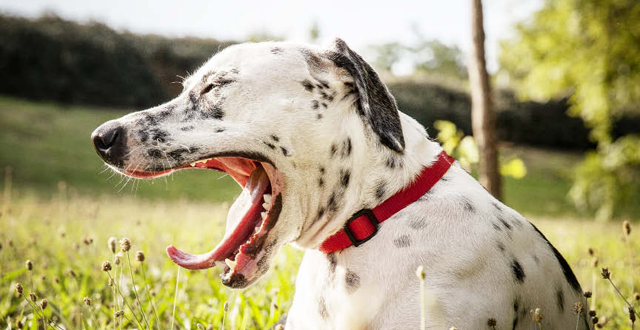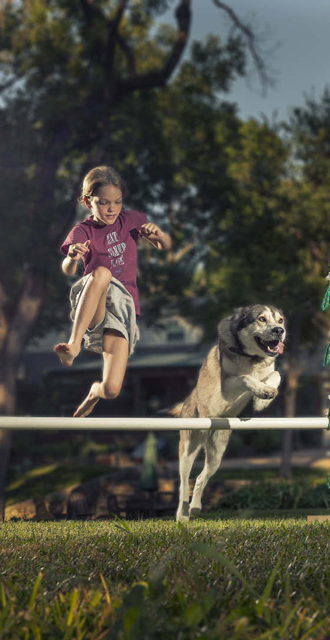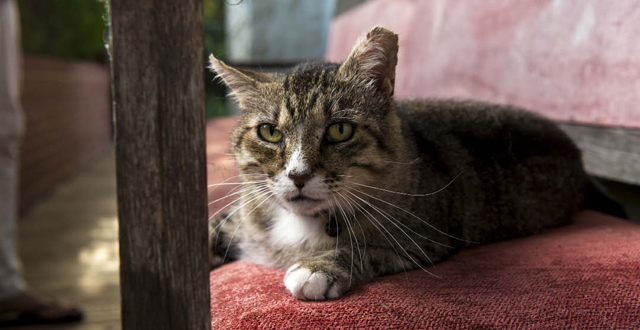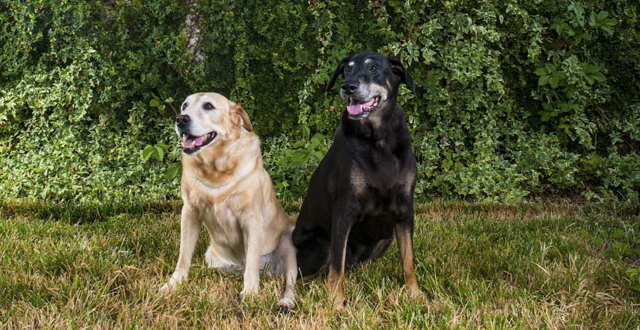It is just an animal …
an inferior species prone to flea infestation, shoe destruction and squirrel abuse, right? Like other cases of true love, man’s connection to domesticated beast defies logic. Pet behavior — slap-happy romping, guttural purrs of pleasure and exuberant expressions of gratitude in the form of unbridled kisses — can inspire profound joy. Conclusively, their companionship can boost the quality of a human life. But no use trying to define how or why humans grow so attached to their fleabags. We would rather show you.
Good luck not falling in love.
Salt, the three-legged Dalmatian
People’s choice winner
 One day this summer, Kathi Kibbel’s craftsman cottage on Clinton Avenue was home to six dogs, a few porch cats and some inside cats, the exact number of which she avoids mentioning.
One day this summer, Kathi Kibbel’s craftsman cottage on Clinton Avenue was home to six dogs, a few porch cats and some inside cats, the exact number of which she avoids mentioning.
“The cats rule the roost over the dogs,” she says.

The pet population of the home Kibbel also shares with her husband, Ish Caraballo, changes as fosters come and go. She’s always looking for friends, acquaintances, friends-of-friends and strangers — any responsible person, really — to take one of her brood. When one finds a permanent home, there is space for another foster.
She opens her bathroom door and retrieves a kitten, a pretty little gal with a damaged eye.
“I found her in the street, and she was near death,” Kibbel says, clutching the kitten to her chest. “She was covered in fleas and malnourished.”
Pets just seem to come to Kathi Kibbel, or maybe it’s that she just can’t look away when she sees an animal in need.
That’s how she found Salt the Dalmatian, who was the pet of two young homeless guys Kibbel met downtown. She noticed the dog had an injured leg, and after talking to the men for a while, she convinced them to let her take the dog.
“I think she must’ve been run over by a car,” Kibbel says of Salt.
Her vet tried to save the leg, and they went so far as to put Salt through hydrotherapy to strengthen it (as a result, the dog now dreads water). Eventually, the vet told Kibbel the leg needed to be amputated.
“She lost her leg the same day we put to sleep our old girl dog that had the very same leg amputated years ago,” Kibbel says. “Her name was Zelda, and she is the reason we did the Pooch Prom [fundraiser] at Lee Harvey’s for two years in a row.”
Kibbel and Caraballo moved to Oak Cliff 13 years ago, and they immediately noticed an abundance of stray cats and dogs. So they started working with animal rescue organizations to capture, vet, spay or neuter, and adopt out as many of them as possible.
Kibbel has become a feral-cat-colony manager for the city of Dallas, so she humanely traps feral cats, hands them off to Dallas Animal Services to be fixed, and releases them back into the neighborhood. She encourages her neighbors to fix their pets. She once took her neighbor’s “mom and dad dogs” to the vet herself to be spayed and neutered, with permission of their owners, because “I was tired of finding homes for their puppies,” she says.
Kibbel has been in the bar business for many years, and Caraballo is a welder by trade and a DJ for fun.
“This is how we give back,” she says.
Pepper, the husky mix
A pack of dogs was running down Lausanne one hot day a couple of years ago, and Jessica Johnson noticed that one of them dropped in the median near Colorado.
The other dogs took off and left him.
“He was so exhausted and winded,” Jessica’s husband, Christian, says. “He couldn’t go on.”
So she stopped, got out with the homeless kit she keeps in her car and approached the dog with crackers and water.
She took the dog home and cleaned him up a bit.
“The first night, he had this howl that was like out of a novel or something,” Christian says. “It was the eeriest, timber-wolf, like, you-think-you’re-in-Alaska howl.”
The Johnsons tried putting pictures of him on neighborhood boards, but no one claimed him. At the vet’s office, they found that the dog had fleas and ticks under all his matted fur, and worse, he tested positive for heartworm. The dog was 10 pounds underweight and, they were surprised to learn, less than a year old.
“Two thousand dollars later, we got him all cleaned up and clear of heartworm,” Christian says.
But Pepper has turned out to be a big, beautiful dog that is an important part of the family. The Johnsons’ 9-year-old daughter, Chloe, is an equestrian, and she’s taught Pepper to jump obstacles.
“He comes when you call. He loves to be obedient,” Christian says. “The dog is the sweetest dog I’ve ever owned, and he wants nothing but to be next to you.”
Clarence, the street cat
(and two of his dog siblings, Daisy and Jelly Bean)
Candice White is a portrait photographer who says she is asked increasingly to shoot people’s pets. The snapshot she captured of her own pet, Clarence, late one night, portrays a proud cat with a rough-and-tumble lifestyle.
“He’s been in so many fights, his ears are battered, and most of his teeth are gone,” White says.
Clarence brings his master mice he kills, and he likes to sleep next to her in her bed at night. He likes being picked up, but he’s not fond of being petted.
White also has two old dogs, a 14-year-old Doberman named Jelly Bean and a 13-year-old lab named Daisy. She has a 15-year-old cat named Harley and a new one, an outside black-and-white cat she calls Catsby.
All of White’s pets have been found or rescued. She found Jelly Bean in Winnetka Heights when the dog was just 3 months old. She had distemper and rope marks around her neck from being tied up in someone’s yard.
“We nursed her back to health, and she’s been the best dog ever,” White says.
White volunteers at the Dallas Zoo and at spay and neuter clinics at Dallas Animal Services.
“I just love animals,” she says. “The unconditional love.”
Alice, the Catahoula mix
Ryan Todd’s girlfriend wanted a husky.
One day while he was working from home, his girlfriend, Liz Lampe, emailed him a picture of a husky she’d found in the Irving shelter. He wasn’t that keen on the idea since huskies shed a lot, but he did want a “big dog” that he could take out in public, a pleasure he doesn’t get from his dachshund, Bear, who Todd says is “kind of a jerk. She only likes me.”
So he went to the Irving shelter to get this husky for his girlfriend, but it already had been taken.
“I started walking around, and every dog was jumping up at the cage, either because they were excited to see me, or they seemed like they wanted to kill me,” he says.
Then he saw this blue merle dog lying in her cage, calm as a monk.
“I was like, ‘Oh, I can’t leave here without a dog,’ ” he says.
So he left with Alice, her “jail name,” and took her home.
Todd started skateboarding when he was about 14, and he still skated a couple of times a week for exercise. He read that Catahoula dogs are a working breed that needs an activity every day.
The first time he tried skating alongside her, it took about half a block before she was off and running.
“She just seemed to love it,” he says. “She gets so excited when it’s time to go. She almost screams as she goes down the street when we first get out.”
He started out skating from home in Winnetka Heights to Oddfellows for coffee. But now, Alice demands about two and a half miles a day.









